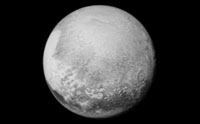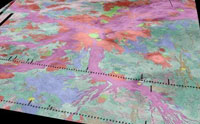A new study investigating the three-dimensional human genome (the nucleome) in the context of time and gene expression revealed unimaginable complexity and precision. The authors of a new research paper, published in the Proceedings of the National Academy of Sciences, wrote at the very beginning of their report, “The human genome is a beautiful example of a dynamical system in three dimensions.” The results of their research spectacularly vindicated this opening statement. More… …read more Read more here: icr.org
By Dr. Alan Gillen In a pure culture growing in a liquid medium, we find that the development and decline of bacterial populations follow a definite, predictable course. …read more Read more here: AIG Daily
By Dr. Alan Gillen Bacteria are prokaryotes and among the most abundant organisms on earth. The vast majority play a positive role in nature. …read more Read more here: AIG Daily
By Dr. Alan Gillen The basic elements of bacterial anatomy include (1) the cell wall and (2) the inner cell body, or cytoplasm. …read more Read more here: AIG Daily
The father gives birth and it has no evolutionary links. It may be the world’s most baffling fish! …read more Read more here: creation.com
Modern machines provide our generation with knowledge entirely unknown in yesteryear. Which of our great grandparents saw footage of water rising through hydrothermal vents on the deep sea floor? New research into water circulating from the ocean, into seafloor crustal rocks, and back into the ocean echoes one of the questions God asked Job thousands of years ago. More… …read more Read more here: icr.org
By Dr. Elizabeth Mitchell Researchers claim to rewind evolution of bird beaks from dinosaur snouts by blocking beak-building genes to revert embryos to their ancestral state. …read more Read more here: AIG Daily
Bacteria sometimes face a rough life. At about a tenth the size of most plant and animal cells, they have no layer of skin to protect them. Environments can change quickly and if microbes don’t have the right tools to adapt, they won’t last long. Bioengineers modeled three interdependent aspects of a metabolic system that bacteria use to thrive in ever-changing environments, revealing an underlying array of interrelated parts that they described as “underappreciated.” More… …read more Read more here: icr.org
The human face is a clear example of overdesign that defies evolutionary explanations. …read more Read more here: creation.com
By Dr. Elizabeth Mitchell With Pappochelys‘s shell characteristics like those of other extinct turtles and a diapsid skull, should creation scientists be having nightmares? …read more Read more here: AIG Daily
By Dr. Danny Faulkner What recent photos of Pluto revealed was a shock to conventional uniformitarian scientists who believe in a 4.5-billion-year-old solar system. …read more Read more here: AIG Daily
Today, more than nine years after its launch, the New Horizons spacecraft is scheduled to make its closest approach to the dwarf planet Pluto. This will make New Horizons the first space probe to examine Pluto and its moons up close during this historic flyby. A NASA press release states, “A close-up look at these worlds from a spacecraft promises to tell an incredible story about the origins and outskirts of our solar system.” But what is the real story? More… …read more Read more here: icr.org
Clues for the Genesis Flood …read more Read more here: creation.com
By Ken Ham The Smithsonian currently has a traveling exhibition exhibited at certain public libraries promoting human evolution titled, “Exploring Human Origins: What Does It Mean to Be Human.” I have written on this traveling exhibit before. In Andover, Ohio, a news report stated that “30 people attended a lecture on why having a baby is so painful and difficult for humans at the Veteran’s Memorial Performing Arts Center on Sunday. The lecture was part of the Exploring Human Origins: What Does it Mean to be Human traveling exhibition, sponsored by the Smithsonian Institution and the Andover Public Library. The [More]
The tortured surface of Venus appears to have been formed through recent geologic processes, and its rocks contain no record of deep time. What if Venus were young rather than 4.5 billion years old? It would explain quite a bit, including a brand-new discovery made by scientists peering through its dense atmosphere. More… …read more Read more here: icr.org
One of the unsolved mysteries of secular science is why so few dinosaurs are found in rocks from supposed tropical regions, especially the Triassic system rocks. Jessica Whiteside of the University of Southampton, UK and her colleagues from eight other institutions have proposed a solution to this enigma. More… …read more Read more here: icr.org
By James J. S. Johnson Examining the battlefield of Fort Mystick, almost 400 years later, can illustrate both the value and limitations of forensic science, showcasing apologetics. …read more Read more here: AIG Daily
Fossilized in the act of mating, these insects were clearly rapidly buried. …read more Read more here: creation.com
By Dr. Georgia Purdom For decades, evolutionary scientists have ignored “ junk” DNA that supposedly littered our genetic sequence. …read more Read more here: AIG Daily
By Dr. Alan Gillen Antibiotic resistance is one of the most important topics that a beginning biology student going into medicine should learn and understand. …read more Read more here: AIG Daily
New science directly challenges the millions-of-years dogma scattered throughout the blockbuster movie Jurassic World. The spring 2015 edition of the Creation Research Society Quarterly (CRSQ) is a special issue that focuses on the investigation of dinosaur proteins inside fossil bones. The last article in the issue presents never-before-seen carbon dates for 14 different fossils, including dinosaurs. Because radiocarbon decays relatively quickly, fossils that are even 100,000 years old should have virtually no radiocarbon left in them. But they do. More… …read more Read more here: icr.org
“Excellent article about evidence for the young age of dinosaur bones.” Admin Collaborative creation research falsifies the evolutionary dates for the alleged ‘age of dinosaurs’. …read more Read more here: creation.com
Deep-time compromise has had a negative effect on the Christian church despite claims to the contrary. …read more Read more here: creation.com
Rather than supporting a belief in evolution, as Richard Dawkins claims, the DNA code points to a designer. …read more Read more here: creation.com
Answering a critic who claims that evolution is proven by trivial biological changes. …read more Read more here: creation.com
By Dr. Elizabeth Mitchell The giant panda’s adaptations for its specialized herbivorous diet may have fit it for its environment through the ordinary processes of natural selection. …read more Read more here: AIG Daily
Scientists used new techniques to sequence 101 ancient human genomes believed to be from Bronze-Age populations in Europe. Their findings indicate a massive migratory influx of genetic diversity just a few thousand years ago. This data also coincides with known language diversification patterns, providing strong evidence for the dispersion of people groups at the Tower of Babel. More… …read more Read more here: icr.org












































